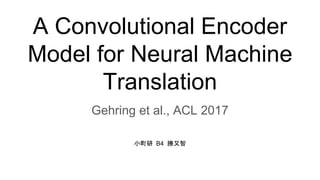
A convolutional encoder model for neural machine translation
- 1. A Convolutional Encoder Model for Neural Machine Translation Gehring et al., ACL 2017 小町研 B4 勝又智
- 2. 概要 ● 通常、MTのencodeは双方向LSTMだが、今回、畳み込みを用いたencoderを 提案する。 ○ 双方向LSTMは逐次的に計算を行うが、CNNなら入力文を平行にencodeできる。 ● 既存のLSTMと同程度の精度を実現。 ○ WMT’16 English-Romanian、WMT’15 En-Ge、WMT’14 En-Fr ● generateについて、精度はそのままでLSTMと比べて2倍以上速い。 ○ IWSLT’14 En-Ge、Ge-En 2
- 3. CNN Encoder のうま味(RNNと比べて) ● 入力文に対して平行に計算を行う。 ● RNNと比べて入力文内の単語の関係性がより短いパス(計算数の話ではない)で取れる。 ○ RNN: sequence length n が必要 ○ CNN: max(1, [(n-1) / (k-1)]) が必要(k: kernel width) ● CNNは入力文の各単語に対して均等に処理を行っていく。 一方でRNNは最初の単語と最後の単語で処理された数が異なる。 CNN RNN 例: 下図 n=4、k=2のとき RNNはそのまま4 CNNは左のように3 3(実際のモデルではストライド1)
- 4. Model : Decoder とか attention まわり Decoder (隠れ層si+1を求める) ● si+1の計算として、 1つ前の隠れ層siと1つ前の出力embedding gi、attentionで計算したciを用いる ○ 具体的にciはgiとconcateしてLSTMに入れてsi+1を求める (siの中にcell vecとhidden vec (hi)) Attention (ciを求める) ● diの計算として、hiを線形変換したものと1つ前の出力giを足す。 このdiとencoder output zj のdot product を計算する。 最終的な出力→ 4
- 5. Model: Baseline (LSTM encoder, pooling encoder) bi-directional LSTM encoder (BiLSTM) ● 入力文をembeddingしたものを順方向と逆方向のRNNに入れてconcateし、 線形変換を行いencode output zを返す。 pooling encoder ● こちらは非再帰的なencoderのbaselineで、k個の連続した単語のembedding の平均をとったモデル。(Ranzato et al., 2015) ● 今回は単語のembedding wjに対して、その単語の入力文における絶対位置を 足した。(ℓj: position embedding) attentionについて aijの計算は先ほどと同じだが ciの計算でzjでなくejを使って いる 5
- 6. Model : Convolutional Encoder ● pooling encoderのようにposition embeddingを行い、畳み込みを行っていく。 ○ pooling layerは持ってない。 ● 畳み込み層を重ねていく。→最終的な出力は複数の文脈を見ているはず。 ○ 畳み込みの入出力はresidual connection (He et al., 2015)を用いている。 ● attention計算のために2つの畳み込み計算を行ってencodeを行う。 ○ CNN_a: aを計算するためのやつ ○ CNN_c: cを計算するためのやつ 6 CNN_a CNN_c (diは2つ前のスライドと同じ)
- 7. 他のCNN Encoder と比べて何が嬉しいのか ● これまでのCNN encoderでは既存のRNN encoderより性能が低かった。 → 今回、既存のRNN encoderに匹敵する性能が出た! ● (Kalchbrenner and Blunsom, 2013) → 文に対して畳み込みencodeを用いた。 ○ sentenceやn-gramに対してCNN encodeを行い、decoderへの入力トークンを生成する。 ○ SMT出力のn-best rescoring で使われた。 ● (Cho et al., 2014) → 固定長の表現が得られるまで繰り返しCNNを用いた。 ○ recurrent encoder の方が高い精度を達成した。 ● (Kalchbrenner et al., 2016) → 畳み込みで翻訳を行うモデル (ByteNet) を提案。 ○ このモデルはattention機構が無く、SOTAに届かなかった。 ● (Lamb and Xie, 2016) → encodeに多層のCNNを用いた。 ○ 量的評価がされていなかった。 ● (Meng et al., 2015) → PBSMTのphrase対のスコア計算に用いた。 ● (Tu et al., 2015) → Dependency-basedSMTのphrase対のスコア計算に用いた。 7
- 8. 実験: Dataset ● IWSLT’14 German-English (異なるencoderの評価) ○ train: TEDとTEDxの字幕データ、頻度3回以下の単語を<unk>化 (En: 24158 words, Ge: 35882 words) ○ (特に記載無ければ)入力文長制限: 175words ← position embeddingの適切な学習を保証している。 ○ trainの文数: 167K, test: 6948 sents (tst2010, tst2011, tst2012, tst2013, dev2010) ● WMT’16 English-Romanian ○ (Sennrich et al., 2016)と同じデータを用いている。→ 学習は2.8M sents用いた。 (En: 200K words, Ro: 80K words) ○ test: newstest2016 ○ BPEは使っておらず、word baseで行っている。 ● WMT’15 English-German ○ train: Europarl v7, Common Crawl, News Commentary v10を用いて、3.9M sentsを使用した。 (En: 200K words, Ge: 80K words) ○ test: newstest2015 ● WMT’14 English-French ○ train: 一般的に用いられる(Schwenk 2014)12M setnsに対して文長制限150wordsを行い、 10.7M sents用いた。(En: 200K, Fr: 30K) ○ test: ntst14 8 validation setについて IWSLT’14: trainの5% WMT: trainの1%
- 9. 実験: パラメータなど ● 共通するパラメータ ○ embedding: 256 dim ○ 重みの初期化: [-0.05, 0.05]の一様分布 ○ mini-bach: IWSLT’14 32 sents、WMT 64 sents ○ dropout: IWSLT’14 0.2、WMT 0.1 (embeddingとdecoder output hiに対して行う) ● Recurrent Model ○ hidden unit: 512 (encoder, decoderどちらも) ○ optim: Adam (step幅: 3.125*10^(-4)) ○ validのpplに基づいてearly stopingを行ってる。 ● CNN Model ○ hidden unit: CNN_a 512 units、CNN_c 256 units、decoder 512 units ○ 窓幅: 3 ○ paddingはencoder output zが入力xと同じ (|x|=|z|) になるように。(fig1を参照) ○ optim: SGD and annealing(最初lr=0.1にして、validのpplが改善しなくなったらlrを減らしていく) 今回はlrの桁を減らしていって、lrが10^(-4)になるまで行う。 9
- 10. 今回の実験の評価について ● IWSLT’14については5つ、WMTについては3つ、seedを変化させて学習したモデルの中から最も 良いvalid pplを出したものを最終的なBLEU評価に用いた。 ● beam searchについて ○ IWSLT’14 はbeam幅10、WMTはbeam幅も別のデータセットを使って調整した。 ● 未知語を出力した後の処理 ○ <unk>を出力した場合、attention scoreが最も高い入力単語を見て、事前に用意した辞書から 対応した単語で<unk>を置き換える。 ○ 辞書になかったら、入力単語をそのまま置き換える。 ○ この辞書はアライメントをとった学習データからとってくる。 (アライメントはfast_align (Dyer et al., 2013) を用いて張る) 10
- 11. Results: IWSLT’14 (Recurrent or 非Recurrent) ● 畳み込み層 ○ CNN_a とCNN_cを1層から10層まで変化させて valid ppl が一番いいものを持ってくる (6層、3層) ● position embedding ○ pos がある→position embeddingを用いている。 11
- 13. Analysis: CNN Encoder について(IWSLT’14) ● CNN_aとCNN_cを分ける話 ○ CNN_cが3層のときがいい感じ、このときCNN_aは6層がいい感じ → CNN_aはCNN_cの2,3倍の層の数にしておくといい。 ○ CNN_aとCNN_cを分けなかったとき 22.9 BLEU(層の数を増やしてもダメでした) ○ CNN_a: 広い範囲の文脈を見て情報を統合してそう CNN_c: 入力単語により近い感じの浅いところを見てそう 13
- 15. Analysis: 入力文長に対しての性能 15WMT’15 En-Ge newstest2015の出力を文長で15分割した
- 16. Analysis: 学習時間と出力時間について ● 学習時間(IWSLT’14) ○ Tesla M40 GPUを使用 ○ single layer BiLSTM: 4,300 target words/second ○ 6/3 convolution encoder: 6,400 target words/second ○ Adamの方がSGDより収束が速いため、全体の学習時間はBiLSTMが速かった。 ● 出力時間 ○ Intel Haswell CPU clocked at 2.50GHzをシングルスレッドで使用した。 ○ IWSLT’14: 1.35倍速いしBLEUも上がった。(hidden layerやembedding sizeも同じ) ○ WMT’15: Conv. 8/4はBiLSTMより2.1倍速い。(encoderのembedding sizeが違う(BiLSTM > conv.)) ○ そもそも1回でLSTMは2つ行列乗算が必要なのに対し、convは行列乗算が1つで良いのが効いてる 16
- 17. まとめ ● 畳み込みネットワークを用いたNMTのencoderを提案した。 ○ recurrentにやるよりも並列化でき、入力文の長距離依存性を短いパスで掴める。 ○ 入力文のposition embeddingを入れたり、attention計算用にCNNを2つ用いた。 ● recurrent encoder と比較して同じくらいの性能が得られた。 ○ baselineとしたBiLSTMとは同じくらいかそれ以上の性能が得られた。 ○ 他の手法と比べてもそれほど悪くはなかった。 ● 出力時間についてもよくなった。 ○ 双方向のrecurrent encoderと比べて2倍速くなった。 ● Future work ○ conv. encoderを用いて収束の速い学習を行いたい。 ○ 文字単位のencoderにも使えそう。 ○ 他のseq2seqのtaskにも適応したい。(summarization, constituency parsing, dialog modeling) ● 個人的感想 ○ 比較について: モデルが既存のものと大きく異なるのにこんな感じ(setting, 評価にBLEUのみ)でいいの...? 先行研究と設定を一緒にしたりしなかったりどういうこと...? ○ CNN encoder: わざわざ使う1番のメリットは時間...?(性能とかパスが云々とかではない感じがした...) ○ 一番興味深かったのはattention用に2つEncoderを用意するところ 17
- 18. 参考サイト、論文 ● facebookの実装 (lua, torch) ○ https://github.com/facebookresearch/fairseq ● Recurrent Continuous Translation Models. Kalchbrenner and Blunsom, EMNLP 2013 ● On the Properties of Neural Machine Translation: Encoder–Decoder Approaches . Cho et al., SSST 2014 ● Neural Machine Translation in Linear Time. Kalchbrenner et al., arXiv 2016 ● Convolutional Encoders for Neural Machine Translation. Lamb and Xie, 2016 ○ (https://cs224d.stanford.edu/ reports/LambAndrew.pdf) ● Encoding Source Language with Convolutional Neural Network for Machine Translation. Meng et al., ACL 2015 ● Context-dependent Translation selection using Convolutional Neural Network. Tu et al., ACL-IJCNLP 2015 ● Edinburgh neural machine translation systems for wmt 16. Sennrich et al., WMT16 2016 ● Schwenk 2014 ○ (http://www-lium. univ-lemans.fr/ ̃schwen /cslm_joint_ paper/) ● A Simple, Fast, and Effective Reparameterization of IBM Model 2. Dyer et al., ACL 2013 18
Notes de l'éditeur
- 論文中には先行研究のgeneration timeも記載あり 2つの行列乗算はrec方向の重みとinputに対しての重みだと思う